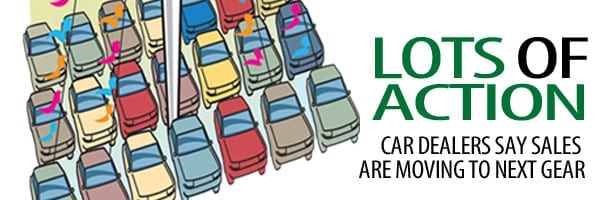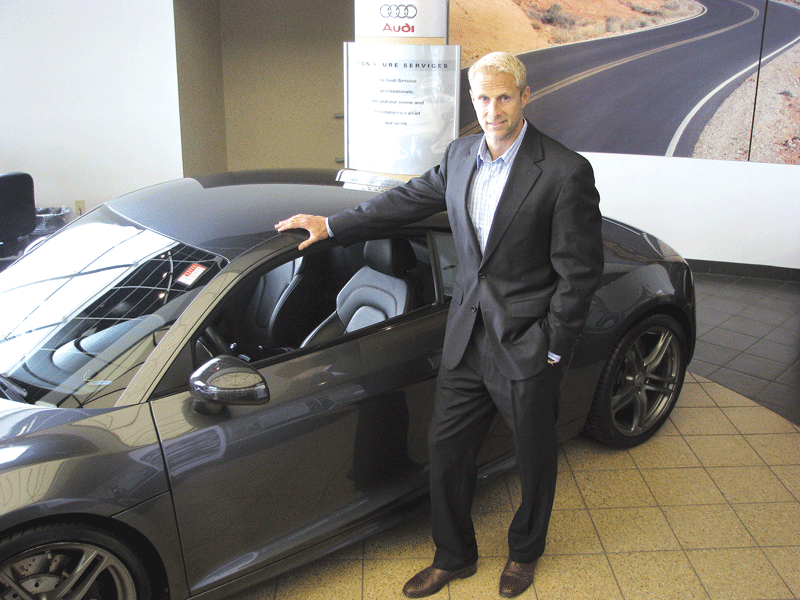
The Next Gear
Carmakers Branch Out as Sales Continue to Increase
 Jeff Sarat calls it “pent-up demand.”
Jeff Sarat calls it “pent-up demand.”
Auto-industry analysts have been saying for years that the average age of all cars on the road is hovering at or over 10 years, each year expecting the dam to break and a good percentage of those motorists to trade up for something newer.
It never seems to happen, but Sarat, president of Sarat Ford Lincoln in Agawam, says there are some indications that people are tiring of squeezing another year or two out of the old beater.
“There’s a lot of pent-up demand out there, and I think that’s helping us,” he told BusinessWest. “We just sold a couple a new Lincoln MKZ; they had a 2002 Cadillac — a 12-year-old car. It was time for them. They wanted to buy a new car two years ago, but they held off for a year or two. But they were at 99,000 miles, and it was just time to trade in that car. And that 10-year average is just that — an average. So you’ve got five-year-old cars out there, and 15-year-old cars. That’s old. And that’s really helping us right now.”
What didn’t help, Sarat said, was a remarkably cold winter that suppressed sales industry-wide.
“In January and February, the snow, ice, and freezing temperatures really hit us pretty hard. We hit our numbers, but it was a real struggle. That was happening everywhere, but especially in New England, because of the cold weather,” he explained, noting that the cold even impacted the rail system that delivers products from factories in the Midwest to dealerships in the Northeast. “Everything was stuck. But now, things are back to normal. Ford and Lincoln have a lot of really good programs going on right now, and they’re getting us where we need to be.”
For Damon Cartelli, president of the Fathers & Sons dealerships in West Springfield and Greenfield, the winter was just a bump along what has been a positive road over the past few years.

Damon Cartelli says luxury carmakers like Audi are starting to offer vehicles at lower price ranges — although not necessarily this $180,000 model — to build brand loyalty with younger consumers.
Sarat and Cartelli aren’t the only ones optimistic about the rest of 2014 and beyond. In fact, just five years after the onset of the Great Recession saw U.S. sales bottom out at 10.4 million, online auto-sales resource Edmunds.com expects that number to reach 16.4 million in 2014, not far off the 2000 peak of 17.3 million. In other words, the cold spell looks to be broken, both literally and figuratively.
Looking Up
Lacey Plache, chief economist at Edmunds.com, notes that sales this year are receiving a boost from a higher number of lease returners than in 2013, many of whom will opt to buy instead of leasing again.
“At the same time, the downside risk to sales growth will be lower as the economy and consumer confidence continue to improve,” she adds. “While economic growth will remain modest overall, enough progress has been made that car buyers will be largely undeterred by the next rounds of U.S. fiscal crises.”
Despite the cold start to 2014, Sarat said the first half of the year saw sales about even with a strong 2013. “Now we’re hoping for a bit of an uptick. This month’s shaping up that way, and I think the second half of the year will be a lot better. That’s what I’m hoping, anyway.”
Sales should be helped by Ford’s annual Summer Sales Event, which offers 0.9% financing on many vehicles. “They’re even pushing pre-owned cars now, which helps us move those cars,” he said. “We’ve got some great lease deals, sign-and-drive, the Ford Focus for $199 a month … we’re selling just about every Focus we can get because of that program.”
Rising consumer confidence is helping to move some of the larger vehicles as well, Sarat said. “I remember five years ago, we needed a $5,000 rebate to sell a Ford Explorer; now we sell them with a $1,500 rebate.”
The Fathers & Sons family of dealerships runs the gamut from its Kia store to its higher-end Porsche, Volvo, Audi, and Volkswagen showroom, and across the board, Cartelli said, sales have been brisk.
“Kia has remained a very strong brand for us. The only problem is getting a sufficient amount of product to satisfy demand,” he noted. “Same thing with Audi — it’s a great brand for us, but we haven’t had enough product to fulfill demand. But with Volkswagen, we do have a good mix of products, so there’s not a concern. And Volvo is coming on strong right now.
“It’s a perfect storm right now, when all cylinders are firing, when we have good sales with all the franchises” he added. “There are lot of times when we have a couple up and a couple down, but when all are clicking at the same time, those are special years.”
Despite a greater willingness to spend, however, buyers are still on the lookout for fuel efficiency. “That’s an overriding thing for all manufacturers. Everyone is trying to figure out how to make cars as nimble as possible while keeping the fuel efficiency high,” Cartelli noted, adding that European manufacturers have also been investing in lighter but stronger metals that boost both performance and fuel economy. “It seems like an oxymoron, but it’s not.”
However, Sarat said people are becoming used to high gas prices, figuring that’s the new norm.
“The last time gas approached $4 per gallon, everyone wanted economy cars, asking, ‘what’s the fuel efficiency?’ I hate to say it, but the general public is used to gas at $3.65 per gallon,” he told BusinessWest. “I know the tank on my truck is 35 gallons, and when I fill it up, it hurts. Yet, people are not mentioning that anymore. It’s in the cormer of their mind, but it’s not the top reason they’re buying or trading.”
Into the Future
What they are looking for is technology. “Connectivity for smartphones is really starting to catch on across all brands,” Sarat said.
Jim Motavalli, who blogs about cars for the New York Times, sees the industry entering an age when budget cars won’t have to be spartan. “Automakers, particularly American ones, have discovered the low end of the market, once ceded to Japan, Korea, and Europe. That means great deals on entry-level cars such as the 2014 Chevrolet Spark or Ford Fiesta,” he writes. “And because there’s fierce competition for the youth market, both have access to the latest high-tech gadgets, through MyFord Touch or Chevy’s MyLink.”
And while driverless cars are still the stuff of science fiction — you can’t sit in the back seat and play with your phone, Motavalli notes — autonomous vehicles will dominate by 2040. “What we’re going to see is a gradual increase in the sophistication of in-car safety equipment. Soon you’ll take it for granted that your car prods you to stay in your lane, warns you when you’re going to hit somebody or go off the road, parks itself, and even takes over for short stretches in traffic jams.”
While automakers work to develop this next generation of high-tech vehicles, Plache notes that the used-car market will soon see a surge in off-lease vehicles and older trade-ins, which is good for budget-conscious buyers. “Growing inventories could mean more deals to attract car buyers, which will appeal to the deal-seeking mentality prevalent since the recession.”
The quest for bang-for-the-buck also means buyers will be increasingly drawn to leasing, she adds. “In general, more car buyers will arrange funding through dealers, with leases and dealer financing supporting over three-quarters of transactions as the share of sales from other funding sources, such as cash and loans from third-party lenders, declines further. Regardless of how they pay, buyers will be less tolerant of the traditionally long-winded negotiations in the dealership, preferring instead to lock in the price and as many other terms of the deal as possible before arriving.”
Meanwhile, luxury automakers are reaching out to consumers with lower-priced models, like Audi’s A3, priced around $30,000.
“That has been a perfect mix for our market demographics, being a personal car, a starter car, if you can call it that,” Cartelli said. “It’s got front-wheel drive, leather, and sunroof, all standard, and it’s $32,000 with all-wheel drive.”
The idea, he said, is to develop brand loyalty with consumers earlier in their lives, so they eventually move up to the A5 or A6. “It puts on the shopping list. It opens the door to a lot more people we can talk to, where before, we just didn’t have a model that fit into that range.”
Other luxury names are doing the same thing, including the Mercedes CLA class, a Porsche crossover SUV, and a Maserati mid-size sedan. At the same time, Plache writes, value brands like Hyundai and Kia are continuing to push the upper price envelope with high-end sedans.
In other words, manufacturers are looking to provide something for everyone.
“If you’re thinking of buying a new car in 2014, the trends are mostly positive. The auto market has gotten incredibly competitive,” Motavalli notes. “That means they’re fighting for market share, and using just about any advantage to get your attention — and your dollars.”
Joseph Bednar can be reached at [email protected]





